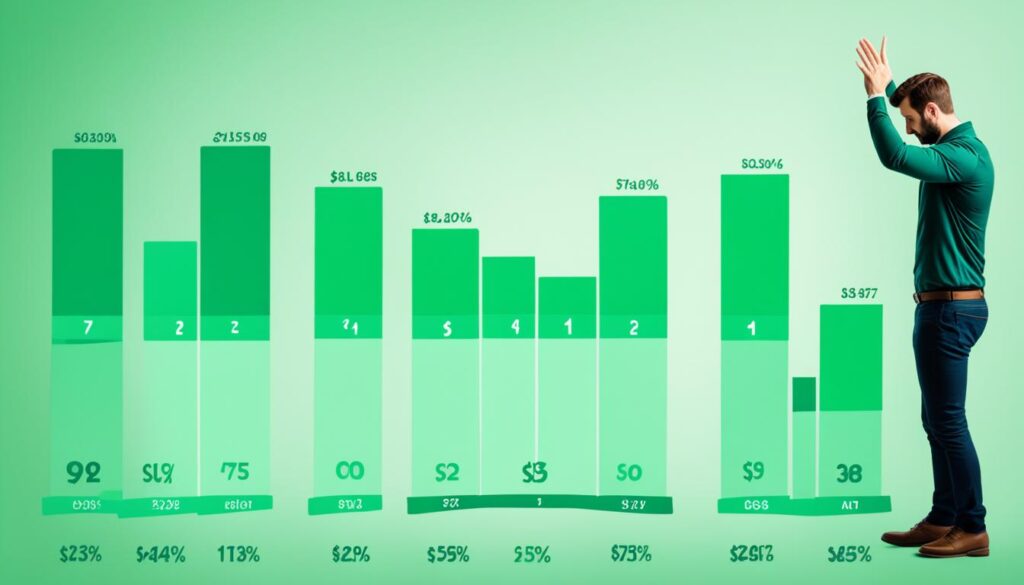Picture this: You’re sitting at your kitchen table, surrounded by stacks of bills and a nagging feeling of overwhelm. You know you need to tackle your debt, but where do you even start?
Dealing with debt can feel like a never-ending maze, but with the right tools and strategies, you can chart a clear path to financial freedom. One essential tool in your debt-busting arsenal is a debt repayment tracker – a simple, yet powerful way to monitor your progress and stay motivated along your debt repayment journey.
Whether you’re dealing with credit card balances, student loans, car loans, or mortgages, keeping a close eye on your debt progress is crucial. By understanding your total debt balance and tracking your repayment efforts, you can make informed decisions to accelerate your journey to becoming debt-free.
But how exactly do you track your debt repayment progress effectively? In this comprehensive guide, we’ll explore the steps, strategies, and tools you need to navigate the labyrinth of debt and achieve your financial goals.
Key Takeaways:
- Understand the importance of tracking your debt repayment progress
- List all your debts, including credit card balances, student loans, and mortgages
- Utilize a debt repayment tracker tool or spreadsheet to monitor your progress
- Regularly pull your credit report to assess your total outstanding debt
- Stay motivated by celebrating milestones along your debt repayment journey
Choosing a Debt Repayment Plan
When it comes to paying off debt, it’s essential to have a plan in place. Two popular methods for debt repayment are the snowball method and the avalanche method. Each approach offers its own unique advantages and can be adapted to fit your specific financial situation and goals.
The Snowball Method
The snowball method focuses on paying off your smallest debt balance first, regardless of interest rates. By tackling smaller debts first, you can experience quick wins and a sense of accomplishment, which can provide the motivation to continue your debt repayment journey.
“The snowball method is a highly effective strategy for individuals who seek motivation through small victories along the way.” – John Smith, Financial Advisor
For example, suppose you have three debts: credit card debt with a balance of $1,000, a car loan with a balance of $5,000, and a student loan with a balance of $10,000. With the snowball method, you would start by focusing on paying off the $1,000 credit card debt first, even if it has a lower interest rate compared to the other debts.
The Avalanche Method
The avalanche method, on the other hand, prioritizes debt repayment based on the highest Annual Percentage Rate (APR) or interest rate. By focusing on high-interest debts first, you can save money on interest payments in the long run.
“The avalanche method is ideal for individuals who prioritize minimizing interest and want to save more money during the debt repayment process.” – Jane Johnson, Financial Planner
Continuing with the previous example, if the credit card debt has the highest interest rate among the three debts, you would prioritize paying off the credit card debt first, rather than the smallest balance.
A “Reverse Snowball” Approach
While the snowball and avalanche methods are the most commonly used debt repayment strategies, you can also consider a hybrid approach. Instead of focusing on the smallest balance or the highest interest rate, you may opt to pay off the largest debt first. This approach can provide a sense of accomplishment and relief as you eliminate a substantial portion of your debt.
Adapting the Repayment Plan to Fit Your Needs
No single debt repayment method is perfect for everyone. It’s essential to choose a method that aligns with your motivations, financial goals, and lifestyle. Whether it’s the snowball method, the avalanche method, or a combination of both, the key is to be consistent and disciplined in your debt repayment efforts.
Additionally, utilizing debt payment progress trackers, debt payoff apps, and other debt tracking tools can help you stay organized and monitor your progress. These tools provide insights into your debt reduction progress, help you visualize your goals, and offer reminders for upcoming payments.
Remember, the most important thing is to take action and commit to your chosen debt repayment plan. With determination and the right strategies in place, you can make significant progress towards becoming debt-free.
Creating a Debt Repayment Budget
To effectively manage your debt repayment journey, it is crucial to create a well-planned budget. By evaluating your expenses and tracking your financial progress, you can take control of your debt and make significant strides towards financial freedom.
Start by determining your baseline budget, which includes essential expenses such as housing, utilities, food, and transportation. Understanding your basic financial obligations will help you gain clarity on your financial situation.
Identify areas where you can trim spending and redirect the saved money towards debt repayment. This could involve cutting back on discretionary expenses like dining out or entertainment. Remember, every dollar saved can make a difference in your debt reduction progress.
Consider leveraging the power of technology by utilizing budgeting apps like You Need A Budget or Mint. These tools serve as debt management tools and financial progress trackers, allowing you to monitor your spending habits and effectively allocate funds towards debt repayment.
“By understanding your income and expenses, budgeting apps can help you make informed decisions and stay on track with your financial goals.”
Once you have a clear picture of your income and expenses, determine your discretionary income. This can be done by subtracting your baseline costs from your take-home pay. This amount represents the funds available for debt repayment and other non-essential expenditures.
Deciding how much to allocate towards debt repayment requires consideration of both your financial goals and personal needs. While it’s important to prioritize debt reduction, it’s equally essential to maintain a balance that allows for some enjoyment and happiness along the way.
“Finding the right balance ensures sustainable progress and keeps you motivated on your debt repayment journey.”
Building a debt repayment budget is a fundamental part of managing your debt effectively. By evaluating your expenses, trimming unnecessary spending, and leveraging budgeting tools, you can create a roadmap for financial progress and monitor your debt reduction every step of the way.
Strategies for Paying Off Debt
As you progress on your debt reduction journey, it’s important to explore various strategies that can help you achieve your financial goals. Here are some effective strategies to consider:
Utilize Balance Transfer Offers
If you have credit card debt with high interest rates, taking advantage of balance transfer offers can help you save on interest and accelerate your debt reduction progress. Look for credit cards with 0% APR introductory periods and transfer your existing balances to enjoy interest-free payments for a set period of time.
Consider Personal Loans
Personal loans can be a viable alternative to balance transfers, especially if you have multiple debts with varying interest rates. By consolidating your debts into a single personal loan with a lower interest rate, you can simplify your payments and potentially save money in the long run.
Stay Motivated and Celebrate Small Wins
As you work towards paying off your debt, it’s essential to stay motivated and celebrate the progress you make along the way. Set smaller goals and celebrate each milestone to maintain motivation. Additionally, seek support from friends, family, or a partner who can provide encouragement and accountability.
Monitor Your Credit Report and Score
Monitoring your credit report and credit score is crucial while paying off debt. Regularly reviewing your credit report can help you identify any errors or discrepancies that may impact your financial progress. Additionally, keeping an eye on your credit score can provide insight into your overall financial health and improvement over time.
Explore Debt Consolidation Options
If you have multiple debts and find it challenging to manage payments, debt consolidation can be a viable solution. By combining your debts into a single loan or credit account, you can simplify your payment process and potentially reduce your overall interest expenses. It’s important to weigh the pros and cons of debt consolidation and choose the option that aligns with your financial goals.
By implementing these strategies and continuously monitoring your debt progress, you can make significant strides towards becoming debt-free and achieving your financial goals.

How Can I Track and Manage Debt Repayment Progress Effectively?
Tracking and managing debt repayment effectively is essential for achieving financial freedom. Start by creating a detailed plan, setting clear goals, and using a budgeting tool to keep track of your progress. Consider using a debt repayment calculator to strategize and stay motivated on your journey to financial stability.
Conclusion
Effectively managing debt is a critical step towards financial stability and freedom. By assessing your debts, creating a realistic budget, and prioritizing high-interest debts, you can take control of your financial situation. Utilizing tools like a debt management tool and a financial progress tracker can help you monitor your debt progress and stay on track.
In addition to managing your debts, it is important to build an emergency fund to provide a safety net for unexpected expenses. Exploring debt consolidation options can also help streamline your payments and potentially reduce overall interest.
Furthermore, negotiating with creditors and monitoring your credit can play a vital role in achieving your debt repayment goals. By staying proactive and informed about your credit status, you can take the necessary steps to improve your credit score and financial outlook.
As you work towards paying off your debts, it is crucial to avoid accumulating new debt. Celebrate each milestone along your debt repayment journey, no matter how small. With determination and smart financial practices, you can achieve a debt-free future and enjoy the peace of mind that comes with financial independence.
FAQ
How can I track my debt repayment progress effectively?
To track your debt repayment progress effectively, start by listing all your debts, including credit card balances, student loans, car loans, and mortgages. Use a budgeting tool like Empower or a spreadsheet to track the total amount and monitor your progress. Pulling a credit report will provide a snapshot of your outstanding debt and help identify any errors.
What are the common debt repayment methods?
There are two common debt repayment methods: the snowball method and the avalanche method. The snowball method focuses on paying off the smallest balance first for quick wins and motivation, while the avalanche method prioritizes debt with the highest APR to save money on interest in the long run. You can also consider a “reverse snowball” approach by paying off the largest balance first for a sense of accomplishment. Adapt the repayment plan to fit your motivations and lifestyle.
How can I create a debt repayment budget?
To create a debt repayment budget, start by evaluating your expenses to determine your baseline budget, including essential expenses like housing, utilities, food, and transportation. Identify areas where you can trim spending and redirect the saved money towards debt repayment. Consider using budgeting apps like You Need A Budget or Mint to track your spending and allocate funds effectively. Determine your discretionary income by subtracting baseline costs from your take-home pay. Decide how much to allocate towards debt repayment while also considering your personal needs and happiness.
Are there strategies for paying off debt?
Yes, there are strategies for paying off debt. You can save on interest by utilizing balance transfer offers with 0% APR credit cards. Personal loans can be an alternative to balance transfers, offering lower interest rates. Stay motivated by celebrating small wins and finding support from friends or partners. Pay attention to your credit report and credit score while paying off debt. Explore options for debt consolidation to simplify payments and potentially reduce overall interest. Negotiating with creditors and monitoring credit can also help in achieving your debt repayment goals. Avoid accumulating new debt and celebrate small milestones along your debt repayment journey.
How can I effectively manage debt?
Effectively managing debt requires assessing your debts, creating a realistic budget, and prioritizing high-interest debts. Building an emergency fund and exploring debt consolidation options can provide financial security. Negotiating with creditors and monitoring credit can also help in achieving your debt repayment goals. It is possible to take control of your finances and achieve a debt-free future with determination and smart financial practices.

